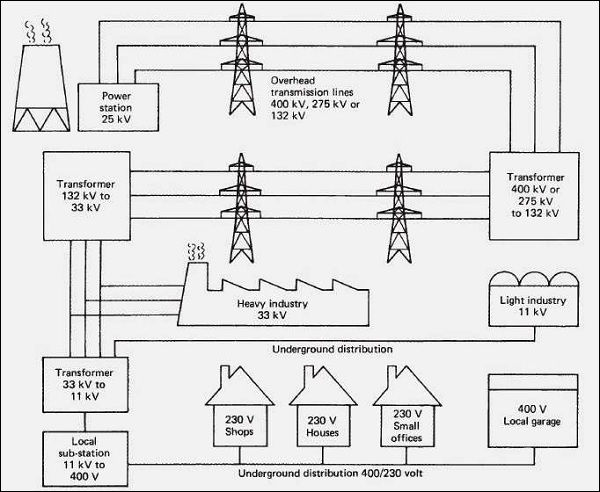
- Electrical Safety Tutorial
- Electrical Safety - Home
- Power System
- Indian Standards
- Low Voltage Overload Protection
- Short Circuit Protection
- Earth Fault Protection
- Earthing
- Types of the Supply System
- Cables
- Classification of Hazard-Prone Areas
- Safety Measures Related to Gas/Ducts/Fibre material
- Classification of Temperature
- Protection Against Weather Complexities
- Safe Electrical Equipment Design Characteristics
- Test Certifications
- Procedure to Mark Unprotected Equipment
- Maintenance of Unprotected Equipment
- Duties and Obligations
- Primary Ex-protection
- Secondary Ex-Protection
- Precautions Against Highly Flammable Contents
- Safety Measures During Handling Lighting Protection Equipment
- Bonding
- Transformer Safety
- Motor Handling Safety
- Generator Handling Safety
- Crane Handling Safety
- Safety Measures During Preventive Maintenance
- Types of Safety Equipment
- Implications of Human Behaviour
- Do's and Don'ts at a Glance
- Electrical Safety Useful Resources
- Electrical Safety - Quick Guide
- Electrical Safety - Useful Resources
- Electrical Safety - Discussion
Types of the Supply System
We will now learn the different types of the supply system. Before we begin, we need to know what power supply is.
Power Supply
The supply of electric power to an electrical load is called power supply. The main function of the power supply is to convert electric current from a source to the correct voltage, current and frequency to power the load. Electrical outlet, energy storage device such as batteries, fuel cells, generator, solar power converters are generally known as power sources.
Power supply is classified into different categories. In our subsequent sections, we will see what the different categories are.
DC Power Supply
Such type of supply supplies a constant DC voltage to the loads. It may deliver from a DC source or an AC source.
AC-DC Supply
AC energy can deliver DC power with the help of a rectifier, which converts the transformer output voltage to a varying DC voltage. The DC voltage passes through an electronic filter, which turns it into an unregulated DC voltage. There is also a register in series with the output to limit charging current and the final output power is fed to the load.
Switched Mode Power Supply (SMPS)
The main input is converted to DC voltage via rectifier and filter and then switched on and off at a high frequency (10 KHz- 1 MHz) by an electronic switch. It has a safety feature to protect the device and the user.
Linear Regulator
Linear regulator converts a varying DC voltage to a constant. There is a current limiting function to protect the power supply and load from overcurrent. It is independent of fluctuation in input voltage and loads impedance to provide a steady value.
AC Power Supply
AC power supply can be taken from the main supply transferred to the desired voltage with the help of step up and step down transformer. This supply is divided into a single-phase and a three-phase system.
Programmable Power Supply
A PPS provides remote control operation through an analog input or digital interface such as RS 232. The controlled properties include voltage, current and frequency (in case of AC).
Uninterruptible Power Supply
UPS has a feature to take power from two or more sources simultaneously. It is used as a backup supply as it takes over the load in dropout or failure condition of main supply. The process is so fast that the load never experiences an interruption.
High Voltage Power Supply
HDPS supplies the bulk of energy, which is hundreds or thousands of volts for applications above 20KV. It includes voltage multiplier or high turns ratio, high voltage transformer or both to produce a high voltage.
Principle of Power Supply
In modern power stations, the generation of electricity is at 25 KV and it is transformed to 400 KV. The number of generator sets are designed to provide the flexibility required power for seasonal variations in loads. The principle is to supply the power to any consumer with a ring system and fed from two directions carefully with proper protection and loss of supply.
The following image shows the distribution of power supply from power station to consumer −

Practice
A trained employee should be engaged in the practice of electrical works. Every electrical work must follow the following codes and standards including −
OSHA’s electrical safety requirements for employee
National Electrical Codes
NFPA 70
Practice for external power supply is applicable for computer, electric vehicle, welding purpose, aircraft power supply and plug-in adapters.
Characteristics of Power Supply
The electrical characteristics of power supply refers to the quality of the power.
- Form factor
- Ripple Factor
- Rated Wattage
- Nominal Voltage
- Operating Voltage Range
- Input Frequency Range
- Efficiency
- Load Regulation
- Line Regulation
- Transient Response
- Hold-up Time
- Protections
- Peak Inrush Current
Questions
1. Which type of power supply needs an analog input?
a) High Voltage Power Supply
b) Programmable Power Supply
c) Switched Mode Power Supply
d) AC-DC Supply
Ans: b
2. Which of the followings are not required in AC-DC supply?
a) Transformer
b) Rectifier
c) Filter
d) Inductor
Ans: d
3. Which of the following is not characteristic of the power supply?
a) Trip time
b) Inrush current
c) Line regulation
d) Ripple factor
Ans: a